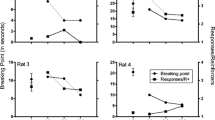Abstract
Pentazocine, cyclazocine, and nalorphine are narcotic antagonists that also have analgesic activity of their own. the present investigation compared the stimulus properties of these three drugs in rats. Each drug was used as a discriminative stimulus for a separate group of rats. Depression of one lever resulted in food reinforcement following the administration of drug, and the opposite lever was reinforced after saline. Each drug readily acquired control of discriminated responding. The specific narcotic antagonist, naloxone, which antagonizes many of the effects of pentazocine, cyclazocine, and nalorphine, also antagonized the discrimination of these drugs. Stimulus generalization tests to each other narcotic antagonist, d-amphetamine, morphine, and LSD, showed that each narcotic antagonist has highly specific stimulus properties. Clear generalization occurred only to pentazocine and cyclazocine in the nalorphine-saline group, but neither cyclazocine nor pentazocine generalized to nalorphine.
Similar content being viewed by others
References
Barry, H., III: Classification of drugs according to their discriminable effects in rats. Fed. Proc. 33, 1814–1824 (1974)
Blumberg, H., Dayton, H. B., George, M., Rappaport, D. N.: N-allylnoroxymorphine: a potent narcotic antagonist. Fed. Proc. 20, 311 (1961)
Fink, M., Freedman, A. M., Resnick, R., Zaks, A.: Clinical status of narcotic antagonists in opiate dependence. In: Agonist and antagonist actions of narcotic analgesic drugs, H. W. Kosterlitz, H. O. J., Collier, and J. E. Villarreal, eds., pp. 266–276, Baltimore: University Park Press 1973
Fraser, H. F., Van Horn, G. D., Martin, W. R., Wolbach, A. B., Isbell, H.: Methods for evaluating addiction liability. (A) “Attitude” of opiate addicts toward opiate-like drugs, (B) A shortterm “direct” addiction test. J. Pharmacol. Exp. Ther. 133, 371–387 (1961)
Gilbert, Martin, W. R.: The effects of morphine- and nalorphine-like drugs in the nondependent, morphine-dependent and cyclazocine-dependent chronic spinal dog. J. Pharmacol. Exp. Ther. 198, 66–83 (1976)
Haertzen, C. A.: Subjective effects of narcotic antagonist cylcazocine and nalorphine on the Addiction Research Center Inventory (ARCI). Psychopharmacologia (Berl.) 18, 366–377 (1970)
Hill, H. E., Jones, B. E., Bell, E. L.: State-dependent control of discrimination by morphine and pentobarbital. Psychopharmacologia (Berl.) 22, 305–313 (1971)
Hirschhorn, I. D., Rosecrans, J. A.: Studies on the time course and the effect of cholinergic and adrenergic receptor blockers on the stimulus effect of nicotine. Psychopharmacologia (Berl.) 40, 109–120 (1974)
Hirschhorn, I. D., Rosecrans, J. A.: Generalization of morphine and lysergic acid diethylamide (LSD) stimulus properties to narcotic analgesics. Psychopharmacology 47, 65–69 (1976)
Hirschhorn, I. D., Winter, J. C.: Mescaline and lysergic acid diethylamide as discriminative stimuli. Psychopharmacologia (Berl.) 22, 64–71 (1971)
Holtzman, S. G.: Effects of nalorphine on avoidance behavior and locomotor activity in the rat. Arch. Int. Pharmacodyn. Ther. 212, 199–204 (1974)
Holtzman, S. G., Jewett, R. E.: Some actions of pentazocine on behavior and brain monoamines in the rat. J. Pharmacol. Exp. Ther. 181, 346–356 (1972)
Holtzman, S. G., Jewett, R. E.: Stimulation of behavior in the rat by cyclazocine: effects of naloxone. J. Pharmacol. Exp. Ther. 187, 380–390 (1973)
Jasinski, D. R., Martin, W. R., Hoeldtke, R. D.: Effects of short and long-term administration of pentazocine in man. Clin. Pharmacol. Ther. 11, 385–403 (1970)
Jasinski, D. R., Martin, W. R., Sapira, J. D.: Antagonism of the subjective, behavioral, pupillary, and respiratory depressant effects of cyclazocine by naloxone. Clin. Pharmacol. Ther. 9, 215–222 (1968)
Kuhn, D. M., Greenburgh, I., Appel, J. B.: Stimulus properties of the narcotic antagonist pentazocine: similarity to morphine and antagonism by naloxone. J. Pharmacol. Exp. Ther. 121–127 (1976)
Lasagna, L., Beecher, H. K.: The analgesic effectiveness of nalorphine and nalorphine-morphine combinations in man. J. Pharmacol. 112, 356–363 (1954)
Overton, D. A.: Discriminative control of behavior by drug states. In: Stimulus properties of drugs, T. Thompson and R. Pickens, eds., pp. 86–110. New York: Appleton-Century-Crofts 1971
Shannon, H. E., Holtzman, S. G.: Evaluation of the discriminative effects of morphine in the rat. J. Pharmacol. Exp. Ther. (in press, 1976)
Author information
Authors and Affiliations
Rights and permissions
About this article
Cite this article
Hirschhorn, I.D. Pentazocine, cyclazocine, and nalorphine as discriminative stimuli. Psychopharmacology 54, 289–294 (1977). https://doi.org/10.1007/BF00426578
Received:
Accepted:
Issue Date:
DOI: https://doi.org/10.1007/BF00426578




